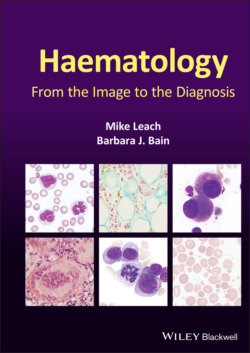Читать книгу Haematology - Barbara J. Bain, Irene Roberts - Страница 35
Оглавление26 Therapy‐related acute myeloid leukaemia with eosinophilia
A 70‐year‐old man developed therapy‐related acute myeloid leukaemia (t‐AML) some years after starting chlorambucil therapy for chronic lymphocytic leukaemia. His FBC showed Hb 63 g/l, WBC 48.9 × 109/l, neutrophils 1.0 × 109/l, lymphocytes 5.5 × 109/l, eosinophils 19.6 × 109/l, monocytes 1.4 × 109/l, myelocytes 0.4 × 109/l, blast cells 21 × 109/l and platelet count 11 × 109/l. There were two nucleated red blood cells per 100 leucocytes. Many of the eosinophils were cytologically abnormal: 25% were hypogranular, 46% were vacuolated and 17% were both hypogranular and vacuolated (all images ×100 objective). Occasional eosinophils had fine basophilic granules (bottom centre) or non‐lobated nuclei. Neutrophils were cytologically normal. The myeloblasts were small and compact with little cytoplasm and prominent nucleoli (right images).
Clonal eosinophils in myeloid neoplasms tend to have more marked cytological abnormalities than those in reactive eosinophilia but there is considerable overlap. It is therefore essential for cytological abnormalities to be assessed together with other disease features. When there is an increase in blast cells, as in the current patient, or when there are clearly dysplastic features in other lineages, such as hypogranular neutrophils, the diagnosis is straightforward. However, if an increase in cytologically abnormal eosinophils occurs without other morphological clues, cytogenetic and molecular analysis may well be needed to confirm the diagnosis of a myeloid neoplasm.
The images above (×100 objective) show hypogranular and vacuolated eosinophils; the cell in the centre image is virtually agranular. Note also the dysplastic platelet (centre) and the megakaryoblast (right); these latter two features together with the eosinophil morphology suggest a clonal haemopoietic disorder, in this case primary myelofibrosis.
Therapy‐related AML is an unfortunate consequence of bone marrow exposure to chemotherapy or radiotherapy used as treatment for neoplastic disease in haematology and oncology practice. As more of these conditions are cured with modern therapy, often using a combination of surgery, chemotherapy and radiotherapy, in breast cancer for example, more patients are surviving to develop therapy‐related myeloid neoplasms. It is not uncommon within haematology to see therapy‐related AML resulting from treatment of another haematological disease, as in the patient described here. We have seen such cases as a result of previous successful treatment for Hodgkin lymphoma, diffuse large B‐cell lymphoma, blastic plasmacytoid dendritic cell neoplasm and acute promyelocytic leukaemia. To be cured of a good‐prognosis leukaemia and develop a poor‐prognosis leukaemia as a consequence is particularly difficult to face.
MCQ
1 Therapy‐related acute leukaemia:Can be associated with 5q−, monosomy 5, 7q− and monosomy 7Can be lymphoblastic or myeloidHas an equally poor prognosis, regardless of the causative agent, the blast percentage or any cytogenetic abnormalities presentHas identical characteristics whether it follows alkylating agents or topoisomerase II inhibitorsIncreases in incidence with the age of exposure to the causative agentFor answers and discussion, see page 206.
